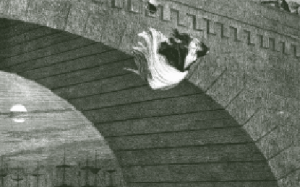Dickens’s ‘fallen women’
Published in 18th–19th - Century History, Features, Issue 5 (September/October 2013), Volume 21
Above: Reformed alcoholic and Dickens’s first illustrator George Cruickshank’s depiction from The drunkard’s children of a distraught young woman leaping to her death from a bridge, colourfully captioned ‘The poor girl, homeless, friendless, deserted, destitute, and gin-mad, commits self-murder’.
Dickens showed genuine concern for London’s prostitutes and other ‘fallen women’. In 1847, along with his good friend the philanthropist Angela Georgina Burdett-Coutts, he established Urania Cottage as a place of refuge and rehabilitation for these unfortunates. Here the regime was at variance with traditional houses of reform such as the Magdalen Hospitals for penitent prostitutes, where women were constantly reminded of their shame as they worked under strict rules at sewing and laundering to earn profit for their keepers. In Urania Cottage a woman was taught domestic skills, could learn to read and write and was offered a genuine opportunity to improve her lot.
Cruickshank, a reformed alcoholic and Dickens’s first illustrator, produced a cautionary series of prints entitled The drunkard’s children. The last of these depicts a distraught young woman leaping to her death from a bridge and is colourfully captioned ‘. . . The poor girl, homeless, friendless, deserted, destitute, and gin-mad, commits self-murder’.
Several Irish writers embraced the theme. In The picture of Dorian Gray, published in 1890, Oscar Wilde allows Lord Henry to tease Dorian thus:
‘Besides, how do you know that Hetty [Merton] isn’t floating at the present moment in some starlit mill-pond, with lovely water-lilies round her, like Ophelia?’
In Mrs Warren’s profession, published in 1894, George Bernard Shaw writes:
‘Liz [Mrs Warren’s sister] went out one night and never came back. I know the schoolmistress thought I’d soon follow her example; for the clergyman was always warning me that Lizzie’d end by jumping off Waterloo Bridge.’
















